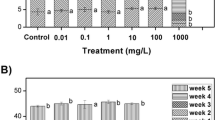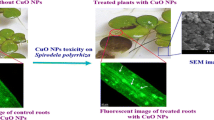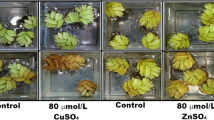Abstract
The adverse effects of zinc oxide nanoparticles (ZnO NPs) with an average diameter of 25 nm on the aquatic plant Salvinia natans (L.) All. were determined. Growth, superoxide dismutase (SOD) activity, catalase (CAT) activity, peroxidase activity, and chlorophyll content of the plants were measured after 7 days of exposure to different concentrations of ZnO NPs (1 to 50 mg L−1). The particle distribution in the culture medium (without plants) during the first 24 h was determined using a Nanotrac 250 particle analyzer. We also investigated the zinc accumulation in leaves and roots of the plant after 7 days of exposure. Exposure to 50 mg L−1 ZnO NPs significantly increased SOD and CAT activities (P < 0.05) and significantly depressed photosynthetic pigments (P < 0.05). However, plant growth was not significantly affected (P > 0.05). NPs completely precipitated at the bottom of the container at 8 h except for the portions of dissolution and aggregation on the roots. ZnO NPs at a concentration of 50 mg L−1 can adversely affect S. natans, and their stress is affected by their aggregation and dissolution.




Similar content being viewed by others
References
Adams LK, Lyon DY, Alvarez PJJ (2006) Comparative eco-toxicity of nanoscale TiO2, SiO2, and ZnO water suspensions. Water Res 40:3527–3532
Aruoja V, Dubourguier HC, Kasemets K, Kahru A (2009) Toxicity of nanoparticles of CuO, ZnO and TiO2 to microalgae Pseudokirchneriella subcapitata. Sci Total Environ 407:1461–1468
Asli S, Neumann PM (2009) Colloidal suspensions of clay or titanium dioxide nanoparticles can inhibit leaf growth and transpiration via physical effects on root water transport. Plant Cell Environ 32:577–584
Borm P, Klaessig FC, Landry TD, Moudgil B, Pauluhn J, Thomas K, Trottier R, Wood S (2006) Research strategies for safety evaluation of nanomaterials, part V: role of dissolution in biological fate and effects of nanoscale particles. Toxicol Sci 90:23–32
Boxall A, Chaudhry Q, Sinclair C, Jones A, Aitken R, Jefferson B, Watts C (2007) Current and future predicted environmental exposure to engineered nanoparticles. Central Science Laboratory, York
Brayner R, Dahoumane SA, Yéprémian C, Djediat C, Ml M, Couté A, Fiévet F (2010) ZnO nanoparticles: synthesis, characterization, and ecotoxicological studies. Langmuir 26:6522–6528
Brunauer S, Emmett PH, Teller E (1938) Adsorption of gases in multimolecular layers. J Am Chem Soc 60:309–319
Buffle J, Leppard GG (1995) Characterization of aquatic colloids and macromolecules. 1. Structure and behavior of colloidal material. Environ Sci Technol 29:2169–2175
Cakmak I (2000) Possible roles of zinc in protecting plant cells from damage by reactive oxygen species. New Phytol 185–205
Dhir B, Sharmila P, Pardha Saradhi P, Nasim SA (2009) Physiological and antioxidant responses of Salvinia natans exposed to chromium-rich wastewater. Ecotoxicol Environ Saf 72:1790–1797
Di Toro DM, Zarba CS, Hansen DJ, Berry WJ, Swartz RC, Cowan CE, Pavlou SP, Allen HE, Thomas NA, Paquin PR (1991) Technical basis for establishing sediment quality criteria for nonionic organic chemicals using equilibrium partitioning. Environ Toxicol Chem 10:1541–1583
Franklin NM, Rogers NJ, Apte SC, Batley GE, Gadd GE, Casey PS (2007) Comparative toxicity of nanoparticulate ZnO, bulk ZnO, and ZnCl2 to a freshwater microalga (Pseudokirchneriella subcapitata): the importance of particle solubility. Environ Sci Technol 41:8484–8490
Gottschalk F, Sonderer T, Scholz RW, Nowack B (2009) Modeled environmental concentrations of engineered nanomaterials (TiO2, ZnO, Ag, CNT, fullerenes) for different regions. Environ Sci Technol 43:9216–9222
Gubbins EJ, Batty LC, Lead JR (2011) Phytotoxicity of silver nanoparticles to Lemna minor L. Environ Pollut 159:1551–1559
Gustafsson Ö, Gschwend PM (1997) Aquatic colloids: concepts, definitions, and current challenges. Limnol Oceanogr 42:519–528
Handy RD, Owen R, Valsami-Jones E (2008) The ecotoxicology of nanoparticles and nanomaterials: current status, knowledge gaps, challenges, and future needs. Ecotoxicology 17:315–325
Heinlaan M, Ivask A, Blinova I, Dubourguier HC, Kahru A (2008) Toxicity of nanosized and bulk ZnO, CuO and TiO2 to bacteria Vibrio fischeri and crustaceans Daphnia magna and Thamnocephalus platyurus. Chemosphere 71:1308–1316
Hu C, Liu Y, Li X, Li M (2013) Biochemical responses of duckweed (Spirodela polyrhiza) to zinc oxide nanoparticles. Arch Environ Contam Toxicol 64:643–651
Jiang HS, Li M, Chang FY, Li W, Yin LY (2012) Physiological analysis of silver nanoparticles and AgNO3 toxicity to Spirodela polyrhiza. Environ Toxicol Chem 31:1880–1886
Kahru A, Dubourguier H-C (2010) From ecotoxicology to nanoecotoxicology. Toxicology 269:105–119
Kim E, Kim SH, Kim HC, Lee S, Lee S, Jeong S (2011) Growth inhibition of aquatic plant caused by silver and titanium oxide nanoparticles. Toxicol Environ Heal Sci 3:1–6
Lecoanet HF, Wiesner MR (2004) Velocity effects on fullerene and oxide nanoparticle deposition in porous media. Environ Sci Technol 38:4377–4382
Lecoanet HF, Bottero J-Y, Wiesner MR (2004) Laboratory assessment of the mobility of nanomaterials in porous media. Environ Sci Technol 38:5164–5169
Li H (2000) Principles and techniques of plant physiological biochemical experiment. Higher Education Press, Beijing, pp 134–137 (in Chinese)
Lichtenthaler HK (1987) Chlorophylls and carotenoids: pigments of photosynthetic biomembranes. In: Lester Packer RD (ed) Methods in enzymology. Academic, London, pp 350–382
Lin D, Xing B (2008) Root uptake and phytotoxicity of ZnO nanoparticles. Environ Sci Technol 42:5580–5585
Love SA, Maurer-Jones MA, Thompson JW, Lin Y-S, Haynes CL (2012) Assessing nanoparticle toxicity. Annu Rev Anal Chem 5:181–205
Ma H, Williams PL, Diamond SA (2013) Ecotoxicity of manufactured ZnO nanoparticles—a review. Environ Pollut 172:76–85
Mandal C, Ghosh N, Maiti S, Das K, Gupta S, Dey N, Adak MK (2013) Antioxidative responses of Salvinia (Salvinia natans Linn.) to aluminium stress and it's modulation by polyamine. Physiol Mol Biol Plants 19:91–103
Masciangioli T, Zhang WX (2003) Peer reviewed: environmental technologies at the nanoscale. Environ Sci Technol 37:102A–108A
Maynard A, Michelson E (2006) The nanotechnology consumer products inventory. Woodrow Wilson International Center for Scholars, Washington, DC
McCord JM, Fridovich I (1969) Superoxide dismutase: an enzymic function for erythrocuprein (hemocuprein). J Biol Chem 244:6049–6055
Miller RJ, Lenihan HS, Muller EB, Tseng N, Hanna SK, Keller AA (2010) Impacts of metal oxide nanoparticles on marine phytoplankton. Environ Sci Technol 44:7329–7334
Nel A, Xia T, Madler L, Li N (2006) Toxic potential of materials at the nanolevel. Science 311:622–627
OECD (2006) Test No. 221: Lemna sp. growth inhabition test. OECD guidelines for the testing of chemicals, section 2, OECD publishing
Peralta-Videa JR, Zhao L, Lopez-Moreno ML, de la Rosa G, Hong J, Gardea-Torresdey JL (2011) Nanomaterials and the environment: a review for the biennium 2008–2010. J Hazard Mater 186:1–15
Petosa AR, Jaisi DP, Quevedo IR, Elimelech M, Tufenkji N (2010) Aggregation and deposition of engineered nanomaterials in aquatic environments: role of physicochemical interactions. Environ Sci Technol 44:6532–6549
Rao MV, Paliyath G, Ormrod DP (1996) Ultraviolet-B- and ozone-induced biochemical changes in antioxidant enzymes of Arabidopsis thaliana. Plant Physiol 110:125–136
Sen A, Bhattacharyya M (1994) Studies of uptake and toxic effects of NI(II) on Salvinia natans. Water Air Soil Pollut 78:141–152
Sharma VK (2009) Aggregation and toxicity of titanium dioxide nanoparticles in aquatic environment—a review. J Environ Sci Health A 44:1485–1495
Shi J, Abid AD, Kennedy IM, Hristova KR, Silk WK (2011) To duckweeds (Landoltia punctata), nanoparticulate copper oxide is more inhibitory than the soluble copper in the bulk solution. Environ Pollut 159:1277–1282
Sun Q, Wang Q, Jena P, Kawazoe Y (2005) Clustering of Ti on a C60 surface and its effect on hydrogen storage. J Am Chem Soc 127:14582–14583
Upadhyay R, Panda SK (2010) Zinc reduces copper toxicity induced oxidative stress by promoting antioxidant defense in freshly grown aquatic duckweed Spirodela polyrhiza L. J Hazard Mater 175:1081–1084
Weckx JEJ, Clijsters HMM (1996) Oxidative damage and defense mechanisms in primary leaves of Phaseolus vulgaris as a result of root assimilation of toxic amounts of copper. Physiol Plant 96:506–512
Wiench K, Wohlleben W, Hisgen V, Radke K, Salinas E, Zok S, Landsiedel R (2009) Acute and chronic effects of nano- and non-nano-scale TiO2 and ZnO particles on mobility and reproduction of the freshwater invertebrate Daphnia magna. Chemosphere 76:1356–1365
Wu B, Wang Y, Lee YH, Horst A, Wang Z, Chen DR, Sureshkumar R, Tang YJ (2010) Comparative eco-toxicities of nano-ZnO particles under aquatic and aerosol exposure modes. Environ Sci Technol 44:1484–1489
Yu LP, Fang T, Xiong DW, Zhu WT, Sima XF (2011) Comparative toxicity of nano-ZnO and bulk ZnO suspensions to zebrafish and the effects of sedimentation, ·OH production and particle dissolution in distilled water. J Environ Monitor 13:1975–1982
Zhu X, Zhu L, Duan Z, Qi R, Li Y, Lang Y (2008) Comparative toxicity of several metal oxide nanoparticle aqueous suspensions to zebrafish (Danio rerio) early developmental stage. J Environ Sci Health A 43:278–284
Zhu X, Wang J, Zhang X, Chang Y, Chen Y (2009) The impact of ZnO nanoparticle aggregates on the embryonic development of zebrafish (Danio rerio). Nanotechnology 20:195103
Acknowledgments
This study was supported by the Shandong Outstanding Young Scientist Award Fund (grant no. BS2010SF005), the Open Fund from the Shandong Provincial Key Laboratory of Water and Soil Conservation & Environmental Protection (grant no. stkf201203), and the fund from Linyi University.
Author information
Authors and Affiliations
Corresponding author
Additional information
Responsible editor: Elena Maestri
Rights and permissions
About this article
Cite this article
Hu, C., Liu, X., Li, X. et al. Evaluation of growth and biochemical indicators of Salvinia natans exposed to zinc oxide nanoparticles and zinc accumulation in plants. Environ Sci Pollut Res 21, 732–739 (2014). https://doi.org/10.1007/s11356-013-1970-9
Received:
Accepted:
Published:
Issue Date:
DOI: https://doi.org/10.1007/s11356-013-1970-9




